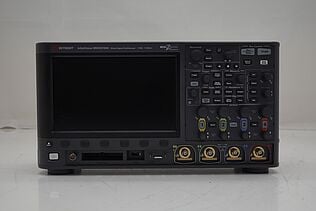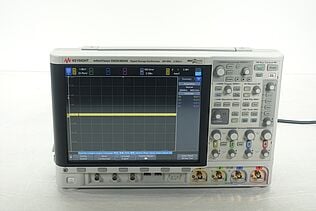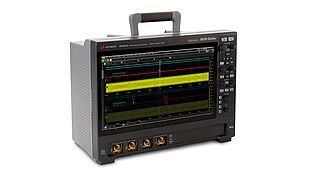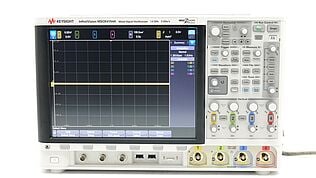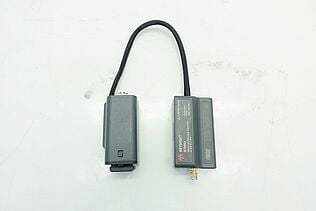- Introduction
- What Is an Oscilloscope?
- Analog Oscilloscope Basics
- Pros and Cons of Analog Oscilloscopes
- Digital Oscilloscope Basics
- Pros and Cons of Digital Oscilloscopes
- Analog vs. Digital Oscilloscopes
- Operation
- Bandwidth
- Sampling Rate
- Memory Depth
- Trigger
- How To Choose the Right Oscilloscope
- Don’t Compromise on Performance! Choose a Keysight Oscilloscope and Maximize Your Test Accuracy
- Whenever You’re Ready, Here Are 4 Ways We Can Help You
As an engineer, you know that choosing the right oscilloscope can be the difference between a successful project and a frustrating setback. But with so many options on the market, it's no easy feat to know which is the right fit for your needs.
The pain of having an oscilloscope that can't keep up with your demanding workload, doesn't provide accurate readings, or simply doesn't have the features you need can be all too real. Sifting through a seemingly endless number of choices and trying to decide which option is best can be an exhausting process. But there is a solution!
In this buying guide, we'll explore the key differences between analog and digital oscilloscopes, helping you make the right decision to prevent the pain of a poor choice and provide a solution that meets your needs and exceeds your expectations.
What Is an Oscilloscope?
An oscilloscope is an electronic test instrument that graphically displays and analyzes signals. It provides a visual representation of a signal's voltage versus time waveform, allowing you to observe and study the behavior of electrical systems. An oscilloscope is commonly used in electronics, telecommunications, and computer engineering fields to diagnose, debug, and design systems.
Another tool that is handy in electronic testing is a multimeter. This test instrument measures electrical properties such as voltage, current, and resistance. While a multimeter can provide valuable information about a circuit, it only gives a single measurement at a specific point in time. On the other hand, an oscilloscope provides a continuous display of the voltage waveform over time, allowing you to observe changes and trends in the signal.
For this reason, an oscilloscope is a more useful tool for analyzing dynamic signals, such as those found in communications systems, power electronics, and other high-speed digital systems. In these applications, the waveform shape, frequency, and stability are often more important than just a single measurement.
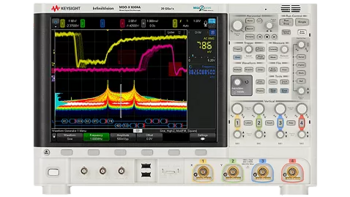
Analog Oscilloscope Basics
An analog oscilloscope is a type of oscilloscope that uses a cathode ray tube (CRT) to display the waveform of an electrical signal. The CRT is a vacuum tube that produces an electron beam to display the waveform on a screen. You also refer to an analog oscilloscope as a CRO or cathode ray oscilloscope.
The key parts of an analog oscilloscope include
- Vertical Amplifier. Amplifies the input signal and applies it to the deflection plates in the CRT.
- Horizontal Amplifier. Amplifies the time base signal and applies it to the horizontal deflection plates in the CRT.
- Time Base. Generates a constant sweep voltage that moves the electron beam from left to right across the CRT screen.
- Trigger Circuit. Synchronizes the sweep to the input signal, ensuring that the waveform displayed is stable.
- CRT. Shows the waveform of the electrical signal.

These parts work together to display the waveform of the input signal accurately. The vertical amplifier amplifies the signal to a level that will produce a visible deflection on the CRT screen. The horizontal sweep amplifier controls the time base, which moves the electron beam across the screen at a constant rate. The trigger circuit ensures that the displayed waveform is stable, making it easier to observe the behavior of the signal over time.

Pros and Cons of Analog Oscilloscopes
Analog scopes have several advantages, making them a popular choice for many applications.
| Advantage | Explanation |
|---|---|
| Visual representation of signals | Analog oscilloscopes provide a visual representation of the waveform of an electrical signal, making it easier to understand the behavior of the signal over time. |
| Real-time display | Analog oscilloscopes provide a real-time display of the signal waveform, allowing engineers to observe and analyze signals as they occur. |
| High-resolution display | Analog oscilloscopes often have high-resolution displays, allowing engineers to observe and analyze signals with greater accuracy and detail. |
| Lower cost | Compared to digital oscilloscopes, analog oscilloscopes are often less expensive, making them a more cost-effective solution for many applications. |
| More straightforward to use | Analog oscilloscopes are often easier to use than digital oscilloscopes, particularly for engineers familiar with the technology. |
| Better for low-frequency signals | Analog oscilloscopes are often better suited for observing low-frequency signals, as they can display waveforms with greater accuracy and stability. |
Overall, the main advantage of analog oscilloscopes is their ability to provide a visual representation of signals in real-time, making them an essential tool if you need to observe and analyze signals over time.
Analog scopes also have several disadvantages.
- Limited bandwidth. Analog oscilloscopes typically have limited bandwidth, making them less suitable for observing high-frequency signals.
- No numerical data. Analog scopes do not provide numerical data, making it difficult to perform quantitative analysis of signals.
- No data storing capabilities. Analog oscilloscopes cannot store data, making it impossible to save and analyze signals over time.
- Maintenance requirements. Due to periodic cleaning and adjustment of the CRT, analog scopes need regular maintenance, which can be time-consuming and costly.
- Poor accuracy and stability. At high sweep rates and low frequencies, analog scopes can be less accurate and stable than digital oscilloscopes.
- Obsolescence. Due to constantly changing technology, analog oscilloscopes are becoming increasingly obsolete as digital oscilloscopes have become more popular and widely used.
Digital Oscilloscope Basics
A digital oscilloscope, also known as a DSO (digital storage oscilloscope) or DPO (digital phosphor oscilloscope), is an electronic instrument that digitally measures and displays electrical signals. Unlike analog oscilloscopes, which use a CRT to display signals, digital oscilloscopes use an internal computer to process and display signals in real-time.
There are several types of digital scopes, including the following:
- DSO (digital storage oscilloscope). A DSO captures and stores signals for later analysis, and you use them for applications where data needs to be saved and analyzed over time.
- DPO (digital phosphor oscilloscope). A DPO is a type of DSO that uses a unique display technology to provide a high-resolution display of signals in real-time.
- MSO (mixed signal oscilloscope). An MSO is a type of digital oscilloscope that can display both analog and digital signals on the same screen, making it useful for applications that require simultaneous observation of multiple signals.
The key parts of a digital scope include
- Analog-to-digital converter (ADC). The ADC is responsible for converting the analog electrical signal into a digital signal that the oscilloscope can process.
- Processor. The processor performs the calculations, processes the signals, and then displays them on the screen.
- Screen. The oscilloscope screen displays the processed signals and can be an LCD (liquid crystal display) or LED (light emitting diode) display.

The ADC is one of the more essential parts of the digital oscilloscope, as it accurately converts the analog signal into a digital format. This digital signal is then processed by the oscilloscope's internal computer, which can perform advanced calculations and provide a more detailed representation of the signal.
Screen types used in digital oscilloscopes include LCD and LED displays. LCDs are commonly used in basic type models and provide a clear and easy-to-read display of signals. You find LED displays in more advanced digital oscilloscopes since they provide a higher resolution display along with larger screens, making it easier to observe finer signal details.

Pros and Cons of Digital Oscilloscopes
Digital oscilloscopes offer several advantages over analog oscilloscopes.
| Advantage | Explanation |
|---|---|
| Improved accuracy | Digital scopes use analog-to-digital converters (ADCs) to digitize the input signals and then show them on the display screen. This results in more accurate waveform representation compared to analog oscilloscopes. |
| Increased storage capacity | Digital oscilloscopes can store captured waveforms in their memory for later analysis. This ability allows you to compare multiple waveforms and store test results for later reference. |
| Enhanced user interface | Digital oscilloscopes typically have a graphical user interface that allows easy navigation and setup. This interface makes it easier for you to get started quickly and make precise measurements. |
| Enhanced measurement and analysis capabilities | Digital oscilloscopes offer a range of measurement and analysis capabilities, including the ability to measure frequency, duty cycle, rise time, and more. |
| Portability | Digital oscilloscopes are typically smaller and lighter than analog oscilloscopes, making them easier to carry around. Additionally, some models can be powered by batteries, making them ideal for fieldwork. |
| Ease of use | Digital oscilloscopes have user-friendly interfaces and do not require complicated calibration procedures. This ease of use makes it easier for you to make measurements and quickly perform complex waveform analyses. |
The main disadvantages of a digital oscilloscope include the following:
- Cost. Digital oscilloscopes are more expensive than analog oscilloscopes, especially for models with high-end features and capabilities.
- Learning curve. Although digital oscilloscopes are user-friendly, they can still have a steeper learning curve than analog oscilloscopes. You will need to learn how to use all the features and capabilities of the oscilloscope.
- Latency. Some digital oscilloscopes can experience latency when capturing and displaying high-speed signals, resulting in waveform distortion or loss of information.
- Complexity. Digital oscilloscopes can be more complex than analog, especially when using advanced features and capabilities. This complexity can make it difficult for engineers to understand how to use the oscilloscope effectively.
- Bandwidth limitations. The sampling rate and ADC resolution limit the bandwidth of digital oscilloscopes, resulting in waveform distortion or loss of information when capturing high-frequency signals.
- Signal degradation. Digital oscilloscopes typically digitize signals before displaying them, which can result in some degradation of the signal quality. This degradation is worse when working with low-level or high-noise signals.
Select up to 3 instruments to compare
Enable Notifications
In order to use this feature, you need to enable notifications.
Manage notification preferences
Analog vs. Digital Oscilloscopes
You may think digital oscilloscopes are the easy winner over analog scopes. But remember the saying, "measure twice, cut once." This saying is a reminder to think carefully about your decision before acting.
The same is true when choosing an oscilloscope. Understanding the differences between analog and digital oscilloscopes is key. Let's look at the operation, bandwidth, sampling rate, memory depth, triggering, and how analog and digital oscilloscopes differ.
Operation
Operation refers to how an oscilloscope operates and acquires signals for display. This specification is important as it directly affects the oscilloscope's ease of use and performance.
Analog oscilloscopes operate using a cathode ray tube (CRT) and a series of amplifiers to amplify and display the input signal on the screen. The signal is then analyzed using various knobs and dials to adjust the display and make accurate measurements.
Digital oscilloscopes, on the other hand, operate using a combination of analog-to-digital converters (ADCs), digital signal processing (DSP), and a graphical user interface (GUI) to display the input signal. They provide more a more detailed waveform representation and a wider range of measurement and analysis capabilities than analog oscilloscopes.
When choosing an oscilloscope, you need to consider your specific requirements and whether you need a high level of detail or a more user-friendly interface. A digital oscilloscope is better if you require high detail and a wide range of measurement and analysis capabilities. An analog oscilloscope may be more suitable if you prefer a more straightforward, hands-on approach to oscilloscope operation.
Bandwidth
Bandwidth is the frequency range that an oscilloscope can accurately measure. It is an important specification to consider when choosing an oscilloscope, as it affects the scope's ability to capture and display high-frequency signals accurately.
Analog oscilloscopes typically have limited bandwidth, usually ranging from 20 MHz to 200 MHz. In comparison, digital oscilloscopes can have bandwidths ranging from 70 MHz to over 100 GHz. Digital oscilloscopes also have the advantage of digitally processing signals to achieve higher bandwidth. At the same time, analog scopes have limited bandwidths due to their analog components.
When choosing an oscilloscope, it is crucial to consider the bandwidth requirements of the signals you will be measuring. If your signals have high-frequency content, you will need an oscilloscope with higher bandwidth to capture and display these signals accurately.
Sampling Rate
The sampling rate of an oscilloscope is the number of samples taken per second to capture the measured signal. It is an important specification to consider when choosing an oscilloscope because it determines the resolution of the signal displayed on the screen. The higher the sample rate, the more accurate the signal representation.
Analog oscilloscopes have a limited sampling rate depending on its gain control circuitry, buffers, and other factors. Digital oscilloscopes use an ADC to digitize the signal, which allows them to take many more samples per second. However, the actual sampling rate depends on the specific digital oscilloscope model and its capabilities.
When choosing an oscilloscope, consider the bandwidth and sampling rate of the signals you will measure. A digital oscilloscope with a high frequency will be more suitable if you work with fast signals with a high sampling rate. If you are working with slower signals, an analog oscilloscope may suffice.
Memory Depth
Memory depth is a specification that refers to the number of samples stored in an oscilloscope's memory. This spec is important because it affects the ability of the oscilloscope to capture and store signals for analysis. The larger the memory depth, the more stored signal information there is, providing a more detailed picture of the signal.
Analog oscilloscopes typically have limited memory depth, as they store signals as an electrical charge on a CRT screen. Digital oscilloscopes, on the other hand, store signals in digital form, allowing for much larger memory depth. This storage is vital for capturing signals with high frequencies or over long periods of time.
Trigger
The trigger function in an oscilloscope initiates the measurement of a signal. It specifies the conditions that need to be met for the oscilloscope to start capturing the signal. The trigger level is an essential aspect of oscilloscopes as it allows you to analyze a particular section of a signal or observe the signal behavior at specific points in time.
Analog oscilloscopes usually have simple trigger systems that are less flexible than digital oscilloscopes. Digital oscilloscopes have advanced trigger systems that allow for multiple trigger events, such as
- Edge trigger
- Pulse width trigger
- Video trigger
Digital oscilloscopes also have more advanced triggering options like a trigger delay, which can capture a signal after a specified time interval and triggering on specific patterns.
When choosing an oscilloscope, the particular trigger function you need depends on the type of signals you will measure. A digital oscilloscope with various trigger functions will be better if you need more advanced trigger options. If you need simple triggering, an analog oscilloscope would be a good choice.
How To Choose the Right Oscilloscope
When selecting an oscilloscope, you will need to consider the specifications of the oscilloscope and how they relate to your application. The bandwidth, sampling rate, memory depth, and trigger functions are all critical factors when comparing analog and digital oscilloscopes.
It's also important to keep in mind the purpose. Such as if you're a hobbyist or a professional engineer, and the environment where you'll be using the oscilloscope. An analog oscilloscope will be a good choice if you need to measure slow signals. A digital oscilloscope will be better for more complex applications, such as measuring fast signals with high sampling rates.
Once you have identified the essential features of your application, you can then compare different oscilloscopes to determine which is best suited for your needs. At Keysight, we have the best of both worlds. We offer premium refurbished oscilloscopes that you can use in various applications, ranging from basic to advanced scopes. Regardless of your application requirements, we have an oscilloscope that will fit your needs.
With our wide range of high-quality, premium, refurbished oscilloscopes backed by a 1-year warranty, you can rest easy knowing you're getting a quality product from a trusted manufacturer. With over 12,600 employees, we have supplied engineers and technicians from over 100 countries with reliable, affordable oscilloscopes.
So don't wait; see our premium used equipment page and pick up a premium refurbished oscilloscope with some of the highest standards and specifications in the industry.
Don’t Compromise on Performance! Choose a Keysight Oscilloscope and Maximize Your Test Accuracy

At Keysight, we understand that your performance is only as good as the oscilloscope you use. That's why we provide high-performance oscilloscopes with the latest features and technologies for accurate, reliable measurements. So if you're in the market for a new oscilloscope, don't compromise on performance–choose a Keysight oscilloscope and maximize your test accuracy.
We offer the perfect combination of performance and affordability. Whether you're a student, hobbyist, or professional engineer, Keysight has the perfect type of oscilloscope for you! Our premium used scopes are calibrated and go through a vigorous 101-point checklist. This testing means you get a like-new oscilloscope while saving up to 70%!
That kind of saving makes Keysight the perfect choice for any budget. So don't wait; check out our selection of premium used oscilloscopes today and get maximum test accuracy and reliability at a fraction of the price.
Whenever You’re Ready, Here Are 4 Ways We Can Help You
- Browse our Premium Used Oscilloscopes offers
- Call tech support US: 1 800 829-4444
Press #, then 2. Hours: 7am – 5pm MT, Mon– Fri - Talk to our sales support team by clicking the icon (bottom right corner) on every offer page
- Talk to your account manager for custom deals

Subscribe to Get Our Latest News, Updates, and Articles.
Select up to 3 instruments to compare
Enable Notifications
In order to use this feature, you need to enable notifications.
Manage notification preferences
